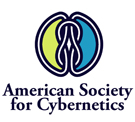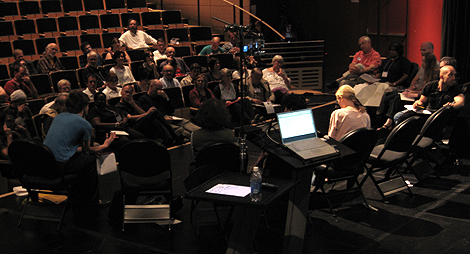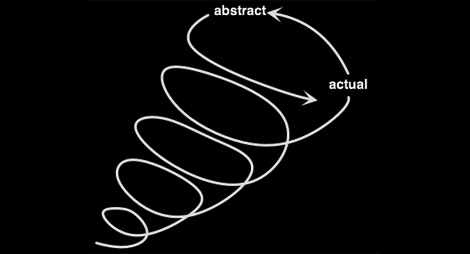Theme 1, Session 2: Fewer, developed questions
In the morning of August 1st C:ADM2010 continued to address Theme 1 of the conference: Actual and abstract: Moving from actual to abstract is understood; but how do we move from abstract to actual? What are the relations between models that are conceptual, computational and physical? how are the differences productive?. To develop as well as to condense the outcomes of the previous session, the conference community split into the same seven working groups and each developed a reduced set of questions or statements addressing the theme as follows below. Rapporteurs of the groups reported the questions back to the conference community with the continuing facilitation of Timothy Jachna.
Group A – Reported by Janet Singer
Group B – Reported by Claudia Westermann
Subgroup 1 of 3
Related question: When to abstract from the actual? Why? When to actualize something abstract? Why?
Response: We abstract the actual to broaden the possibilities of actualizing the abstract which does affect the world. To be able to abstract, you need to have experiences and you will have to break at least one rule. Adding a rule is changing; therefore breaking the rules.
Subgroup 2 of 3
How do vested interests* determine and sustain the the rules for going from the actual to the abstract and back?
* e.g. of a small elite
Subgroup 3 of 3
How do we talk about distinctions between actual/concrete (experiences) and abstract (explanations) in terms of both problem solving and desire?
Group C2 – Reported by Vijak Haddadi
We started by conceptually exploring the relation between model and pattern and converged on the model as a tool or heuristic for visualizing an abstract idea, and a pattern as a tool for constructing or recognizing an order. We then talked about the quite different concepts of model and pattern in mathematics and discovered that the pattern could be seen as a resonance between external physical programming and internal biosemiotic or neuro-linguistic programming. Eventually we asked whether it is possible to present dynamic processes through models or whether the latter are always deficient in that they fail to adequately grasp process.
Group D – Reported by Leonie Solomons
The three chosen questions from the previous discussion of Group D were: 2, 3&4, 5.
We had a rich discussion working as a single group and discussed our questions in the contexts of the constitution for a country, classical and jazz music noting the distinction where one is conducted and the other works in improvisation mode where the lead is played differently.
We concluded on the note that the diversity of views and the particulars discussed gave much food for thought – learnt many things to reflect upon.
As our discussion progressed we linked our ‘purpose’ question to the question pertaining to ‘abstract/actual – few/many relations as regards arriving at working relations’.
A realisation began to emerge that it was not a matter of abstract having more or less number of relations than the actual. Rather it was a matter of the requisite variety of the relations as it pertained to the working relations as it pertained to the purpose – meaning the purpose of the abstract or purpose of the actual.
An important realisation was that purpose is not static – it needs to adapt. Thus an important consideration in design is ‘how does the purpose of the system adapt itself’.
Our discussion of constitutional matters lead is to discuss what does resolution mean? We came to an understanding that at meta-level there needs to be common over-arching purpose in spite of the conflict. Another was the need to arrive at accommodation of differences so you can more forward.
For our third question – we reached the stage where we re-formulated our question to be:
What would be the consequences of abstracting and actualizing being considered as process rather than ‘abstract’ and ‘actual’ as characteristics? Can this question be illuminated by understanding how abstracting and actualizing is enacted in different domains?
Group E – Reported by Joanna Wlaszyn
- How does the abstract require situating in order to be understood?
- How can we share important cybernetic principles in order for them to be beneficial in society? E.g. global warming and equitable resource distribution.
- How do our abstractions shape and constitute the actual that we experience?
We, like group F, were interested in play – although we approached it still by talking about it.
In retrospect we implicitly decided that the 3rd question was implicit in the others. We focused on the first two and we noticed that a particular theme emerged.
Starting with the first question we talked about context – particularly with respect to time – history, stories, games, our biographies…and how these are important in situating abstract understandings.
We then went on to discuss the second question – particularly around sharing. after a wide discussion we again came back to games and stories.. in an educational context Gary noted from his experience that it was important for students to contextualise concepts within their own life.. that they use it for something…(but for more than just passing the course).
We noticed a theme of the importance of simulations, games and stories for communicating (abstract) cybernetic ideas. it seems important that cybernetics and art are made actual… so not to get stuck within their own abstractions. Looking at the landscape I said it was beautiful. A typical second order cybernetic response might be that that says more about me than about the landscape. This is interesting but it makes it difficult to talk about the landscape without talking about talking about the landscape.
We concluding by pondering when recursive thinking becomes unhelpful (when we want to talk about the actual) and how we might talk more directly about actual things.
Group F – Reported by Willie Yee
- How is one’s everyday life effected by abstraction? “Going from abstraction to action is moving from one state of mind to another state of mind.”
- Simulation is the intersection of art, design, and mathematics. At best, simulation is the intersection of art, design, and mathematics. What else is in that intersection?
- What kind of process to we want to trigger by introducing play in the cybernetic discussion. WE WILL PLAY. Play in a system enables adaptation.











Add group G when I find it.